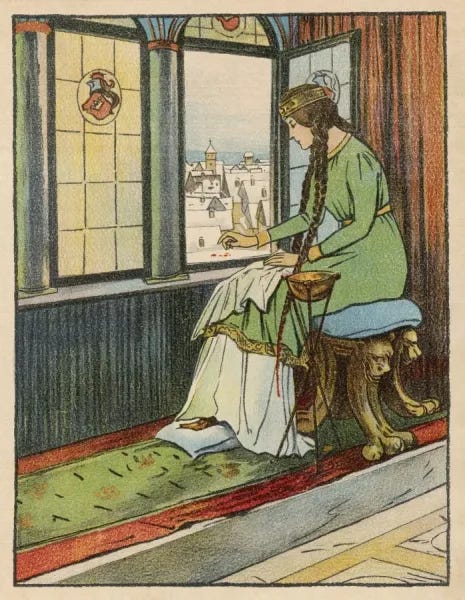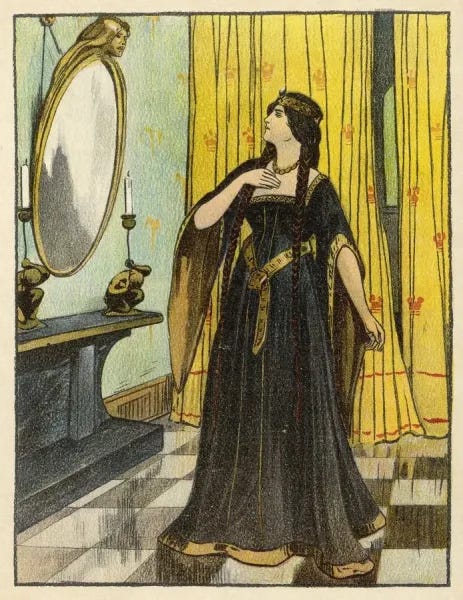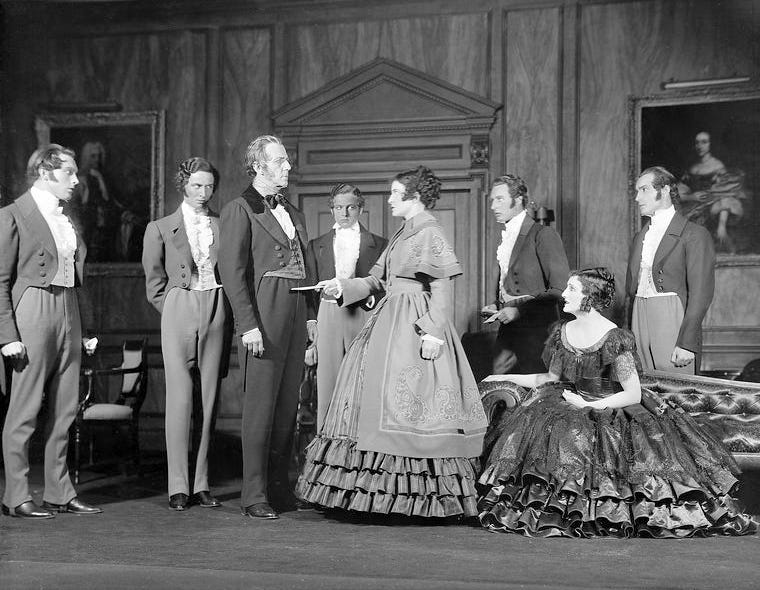Hello, I’m Kate Farrell, author of The Fairy Tale Heroine, exploring the hidden terrain of the heroine’s unique quest—how it can empower your life and inspire your creative work. As a lifelong storyteller, I discovered that the age-old, foundational folk and fairy tales of the heroine’s journey had survived by word of mouth over millennia, often from matriarchal cultures.
In the last two episodes, we discussed major, archetypal characters in the feminine quest. These were the three mothers: the loving mother who dies, the evil stepmother, and the spiritual, magical older mother. We met the cruel, jealous stepsisters, who with the stepmother are enemies of the heroine and seek to demean and destroy her. Yet our heroine is trapped, under their control.
In this episode, we will explore the standards of feminine beauty, an ongoing theme in the Fairy Tale Heroine’s journey tales—one that continues to confront women in a self-defeating battle. It is famously fought in the epic tale of “Snow White” and its all-seeing mirror.
That mirror now falsely reflects a modern, worldwide standard of feminine beauty: thinness, firmness, and youth. Beauty trends are set by what we see on screens and in metaverses, what is possible on screens, with filters, AI effects, and fillers.
In this pervasive, media environment, how do women escape to realize their own, unique beauty and be recognized? I provide a glimpse in my personal story.
As you listen to the excerpt of “Snow White,” imagine your own daily mirror and how you measure your own beauty—and that of others.
“Snow White”
When I reread this ancient fairy tale, I realized how destructive the imposed standards of feminine beauty can be, similar to the queen’s murderous ploys against her step daughter—how we must escape them, to be our beautiful, heroic selves.
This version of “Snow White” is based on the 1812 Grimm Brothers’ collection, Household Tales.
Once in midwinter, when the snowflakes were falling like feathers from heaven, a queen sat sewing at her open window framed in black ebony wood. As she sewed she looked up at the snow and pricked her finger with her needle. Three drops of blood fell into the snow on the window sill.
The red on the white looked so beautiful that she thought to herself, "If only I had a child as white as snow, as red as blood, and as black as ebony."
Soon afterward she had a little daughter who was as white as snow, lips as red as blood, and hair as black as ebony, so they called her Snow-White. But soon after the child was born, the queen died.
A year later the king took himself another wife. She was a beautiful woman, but she was proud and arrogant, and she could not stand it if anyone surpassed her in beauty. She had a magic mirror. Every morning she stood before it, looked at herself, and said:
Mirror, mirror, on the wall,
Who is fairest of all?
To this the mirror answered:
You, my queen, are fairest of all.
Then she was satisfied, for she knew that the mirror spoke the truth.
Snow White grew up and was ever more beautiful. When she became a maid, she was as beautiful as the light of day, even more beautiful than the queen herself.
One day when the queen asked her mirror:
Mirror, mirror, on the wall,
Who in this land is fairest of all?
It answered:
You, my queen, are fair; it is true.
But Snow-White is a thousand times fairer than you.
The queen took fright and turned green with envy. From that hour on whenever she looked at Snow-White her envy and pride grew, like a weed in her heart, until she had no peace day and night.
Then she summoned a huntsman and said, "Take the maid, Snow-White out into the woods. I never want to see her again. Kill her, and as proof bring her liver back to me."
The huntsman obeyed and took Snow-White into the woods. He took out his hunting knife and was about to stab it into her innocent heart when she began to cry, saying,
"Oh, dear huntsman, let me live. I will run into the wild woods and never come back."
The huntsman took pity on her, and he said, "Run away, you poor child." He thought, "The wild animals will soon devour her anyway."
Just then a young boar came running by. He killed it, cut out its liver, and took it back to the queen as proof of Snow-White's death.
The poor maid was now all alone in the great forest, and she was so afraid she did not know what to do. Then she began to run. She ran over sharp stones and through thorns, and wild animals jumped at her, but they did her no harm.
She ran as far as her feet could carry her, and just as evening was about to fall, she saw a little house and went inside to rest.
I’ll end the tale here, but we know that Snow White is still not safe from her stepmother, who soon will follow her into the woods.
Reflections
What is the motivation of the stepmother?
What does she symbolize in today’s “beauty” culture?
How do you escape the overwhelming standards of feminine beauty?
Personal Story: Teenage Beauty
In our teen years, we begin to define ourselves as beautiful young women—it can be exhilarating and painful. If we measure ourselves to an impossible standard, we will damage our own self-esteem and diminish our development, while yearning to assert our individuality.
But sometimes in our struggles to either stand out or to conform, we are gifted with a glimpse of our true beauty.
My Story
A high school freshman in 1955, I attended Our Lady of the Lake High School, a girls' convent boarding school on the far Westside of San Antonio, Texas, but as a day student. The boarders were girls from wealthy Central and South American families who lived in the grand Victorian school, but us day students were an ethnic mix of girls influenced by the Latino Westside neighborhood, a barrio with a proud heritage.
It wasn't long before I cut my hair short in a D.A. or duck's ass, sleek wings in the back with curly bangs; put heavy starch in my school uniform's white shirt so the collar would stand straight up in the back; wore blue suede shoes, penny loafers like Elvis; and learned how to bop to rockabilly music. I wanted to be seen and heard—to take a stance outside the norm for a teenage girl in the 50s.
Looks weren’t important to us Westside day students—attitude was everything!
Soon, my parents learned of my cutting class, ignoring homework, getting poor grades. They consulted the nuns who suggested I transfer to their newly built girls' high school downtown, Providence.
That high school building was a white, two-story cement block with rows of blank windows set on barren grounds, just across the street from the imposing, all-boys' Central Catholic High School. Providence students were mostly middle class, white girls, entitled, full figured. With movie stars like Marilyn Monroe and Elizabeth Taylor, they aspired to be young sweater girls.
For the first time, I felt ashamed of my thinness, my bony elbows—skinny, gawky, flat chested, wearing horn-rimmed glasses. So, I faded away to become invisible in that strict, quiet school.
Until the senior play! I enjoyed it all, with male actors recruited from a Catholic university. The class beauty, blond, blue-eyed Betty, had the lead role of Elizabeth Barrett in The Barretts of Wimpole Street. My small part was an elderly woman with a gray wig and make-up wrinkles, who opened her umbrella to warn off the tyrant, Mr. Barrett, in a comic bit.
One night in rehearsal, as we all sat around chatting, one of the college students, Glen, asked, “Who do you think is the most beautiful girl in the play? Now, I know you’re all thinking it’s Betty. But Kate is the most beautiful girl to me. There’s a depth of feeling in her eyes. She just shines. I can’t look away.”
Ha! I was the last person in the cast to be thought beautiful. I just grinned and let Glen’s words sink in. Invisible, playing a wrinkled, old woman in the senior play—yet a sweet, young man saw my beauty.
Reflections
What do you imagine Glen saw in me?
Who has recognized your true beauty at any time in your life?
How do you describe your most beautiful self?
Write your own “Mirror, Mirror” story.













Share this post